Part of our job here at Motorcyclist is to test and report on motorcycles and gear to give you the enduring benefit of our well-considered and unbiased opinion. Another part of our job is to offer an incredibly valuable unpaid service to the motorcycle manufacturers, politely and thoroughly telling them where they’ve gone wrong and, when we can, proving that the machines they’ve somehow nurtured from idea to real salable product can be dramatically improved for just, oh, a few thousand dollars. How roomfuls of engineers can get it so wrong is sometimes just a little beyond us.
Okay, it doesn’t work that way. As far as we can tell, those engineers don’t stay up late at night worrying about what we think—mainly because we’re the outliers, the enthusiasts who want every bike to be lighter, faster, more compelling to ride. Because we’re too cheap and underpaid to buy them, they don’t make bikes for us, so sometimes we have to take matters into our own hands.
Just that happened with the 2013 Yamaha FJR1300 we “upgraded” with a few kilobucks of aftermarket goodies. High on that list were suspension upgrades in the form of a Traxxion Dynamics-tweaked fork and a Penske shock. As we reported (“More Sport, Same Tour,” Dec. 2013, MC), the FJR responded beautifully to stiffer, higher-quality suspension, gaining sporting poise without sacrificing highway comfort. We called it a win for the red-blooded enthusiast.
We’d like to think Yamaha agrees with our tactics and responded with the 2014 FJR1300ES, but we know better. This machine has been on sale in Europe for the last year, albeit coupled with Yamaha’s no-clutch transmission. For the time we had an “AE” version of the FJR in our country, it sold poorly; Americans, it seems, still want to shift on their own.
For this generation of the FJR, Yamaha has elected to separate the upgraded suspension of the FJR1300AS from the auto-clutch model to create the FJR1300ES (called the AE in Europe; don’t ask us why). We’re delighted that Yamaha sees the potential in the sport-touring market to bring the ES here for ’14. If you’ll think back to the origins of the FJR, Yamaha was so concerned that it would become a dusty planter on dealership floors that it created a pre-order scheme to judge demand before bikes were shipped. Needless to say, the FJR was very much the hot ticket and has remained a staple of the category since we got it in late 2002 as an ’03 model.
Even now in the base FJR, Yamaha’s retained a suspension setup not very far removed from the original machine’s—no doubt a cost-saving measure, but let’s remember that technology has moved along since 2001. But that’s just changed. In place of the YHSJ (which stands for Yamaha Hydraulic System Japan, formerly SOQI) conventional fork with beefy 48mm legs and a YHSJ shock with adjustable rebound damping and a two-stage spring adjustment (not preload), the new ES has an inverted KYB fork with 43mm stanchions and a new, multi-adjustable KYB shock.
But the big news is that these components are electrically adjusted. Using a system similar to BMW’s ESA (Electronic Suspension Adjustment), the FJR’s components have their damping settings changed by small electric motors. Spring preload is adjustable (at the rear only) through an electrically powered hydraulic actuator that moves a piston on top of the shock spring. (Think of the motor replacing the familiar twist knob on a remote preload adjuster.) Note that the FJR does not use a form of active suspension like BMW’s Dynamic ESA or Ducati’s Skyhook; the ES’s arrangement simply replaces mechanical spring and damping adjusters with electric motors. Once they’re set, the suspension components act like normal pieces.
With the redesign last year, the FJR gained a new instrument cluster with a multifunction gauge in the right-hand quadrant. That screen comes into play for the suspension adjustments on the ES. Flick over to the proper screen using the Menu button, which is placed where the flash-to-pass button normally is on the left switch cluster. (Er, it’s under your left index finger.)
At any time when the bike is switched on, one of the menu items manages damping settings, as evidenced by a small shock absorber icon. Using the large rocker on top of the left switch cluster, you can switch among Soft, Standard, and Hard damping schemes. When you change the setting, listen for the small motors moving the damping screws. Up front, both compression and rebound change based on commands from the ECU. With the new inverted fork, Yamaha has put damping on both legs again—the revised fork on the ’13 bike has a cartridge on one side only—with separate functions; one leg adjusts compression damping, the other does rebound. The shock has a single electric adjuster that manages both compression and rebound values.
Unlike BMW, which would stop by giving you three basic damping schemes, Yamaha offers options. For each of the three base settings, you can skew the total damping rates by three steps above and below the baseline, giving you a total of seven schemes for each of the Soft, Standard, and Hard settings.
Dialing in the suspension for varying loads is equally easy. With the engine running but in neutral, push the Menu button once more. A shock-spring icon appears along with helmet/bag icons. There are four settings: one helmet (solo), helmet plus bags, two helmets (two-up), and two helmets with bags. Going from solo to solo with bags adds 2mm of spring preload; adding the passenger notches preload by an additional 4mm, while going to the fourth setting (bags and passenger) provides a final 2mm of preload. What’s more, the seven-stage damping skew factors are set independently for spring preload; if your default for Hard is the +3 skew on the solo-rider setting, it can be something else as a default under different load schemes. Yamaha avoided the temptation to make things too simple and in so doing has given expert “programmers” a lot more flexibility. Well done.
So is the physical execution. Yamaha says the suspension is just 1.2 percent stiffer front and rear, but it feels like more. Although the ES isn’t quite as firm as our Project FJR, it’s a useful upgrade in sporting capability without sacrificing any suppleness. Move through the suspension modes and you can feel the legs firming up and the ride becoming more taut. The difference from the softest to firmest settings isn’t as pronounced as it is in the Ducati Multistrada, but it’s a huge upgrade over the non-ES version of the FJR, which went from far too soft to merely just too soft.
On an entertaining back road, the FJR-ES is less likely to drag hard parts than the A model, though it still leaves more peg feeler behind than did our Project FJR. (We bought more cornering clearance with a stiffer spring and additional ride height, which also raised seat height, not the favorite upside for shorter riders.) Overall, the improvement in the FJR’s sporting side is more than we expected if not exactly a black-and-white change in character. This is, after all, a touring machine, so rock-hard suspension action was never going to be in the frame.
Having the suspension adjustment fingertip-convenient pays dividends. One stretch of our local highway is notoriously rough—CalTrans must have used the lowest bidder on that job—and while we preferred the Standard or even Hard settings most of the time, flicking over to Soft -3 for that stretch takes a second or two but results in a substantially plusher ride. Where you might not bother changing suspension settings on the regular FJR—living with the compromises—you’re much more likely to take advantage of the electronics on this machine.
Suspension dominates the discussion because it’s among the very few changes from the FJR1300A. Yamaha left the engine and chassis alone, aside from one small triumph for hooliganism. In an undocumented change, the maximum set point for the electronic cruise control is now 103 mph where it was 82 mph before. No, there still isn’t a sixth gear, but the more we ride the FJR the less convinced we are that extra cog would be worth the cost of redesigning the engine’s bottom end. We’ve said it before but it bears repeating: The FJR embraces an excellent set of compromises in an inherently bifurcated segment. It’s just sporty enough to be interesting and more than comfortable enough to make serious long-distance work not just possible but eminently enjoyable.
By changing what most needed to be changed and leaving the rest alone, Yamaha has maintained continuity for the aftermarket, retained the strengths of the A-model machine—superb ergonomics, smooth engine, roomy bags, and an overall scale that keeps it from feeling mammoth in LA’s traffic—and kept a lid on price and weight. To that point, the ES costs $16,890—just $1,000 more than the FJR1300A—and the hardware adds a mere 8 pounds, less than 2 percent! We dumped nearly that much money into the rear shock alone for our modded FJR. We could say Yamaha took our excellent advice in the ways to improve the FJR, but the fact is that we just got beat at our own game.
tech Spec
Evolution
Aside from electronically adjusted suspension components, this FJR-ES is mechanically identical to the FJR1300A.
Rivals
BMW R1200RT, Honda ST1300, Kawasaki Concours 14, Moto Guzzi Norge GT, Triumph Trophy SE
Tech
Price: $16,890
Engine type: l-c inline-four
Valve train: DOHC, 16v
Displacement: 1298cc
Bore x stroke: 79.0 x 66.2mm
Compression: 10.8:1
Fuel system: EFI, ride by wire
Clutch: Wet, multi-plate
Transmission: 5-speed
Measured horsepower: 123.0 bhp @ 8100 rpm
Measured torque: 86.8 lb.-ft. @ 6400 rpm
Corrected 1/4-mile: 10.82 sec. @ 122.47 mph
Top-gear roll-on 60-80 mph: 3.66 sec.
Fuel mileage (hi/low/avg.): 45/33/40 mpg
Frame: Aluminum twin-spar
Front suspension: KYB 43mm fork with electronically adjustable compression and rebound damping
Rear suspension: KYB shock with electronically adjustable spring preload, compression, and rebound damping
Front brake: Dual Nissin four-piston calipers, 320mm discs with ABS
Rear brake: Nissin one-piston caliper, 282mm disc with ABS
Front tire: 120/70ZR-17 Bridgestone BT-023
Rear tire: 180/55ZR-17 Bridgestone BT-023
Rake/trail: 26.0°/4.3 in.
Seat height: 31.7 - 32.5 in.
Wheelbase: 60.8 in.
Fuel capacity: 6.6 gal.
Weight (tank full/empty): 676/636 lb.
Color: Candy Red
Available: Now
Warranty: 12 mo. unlimited mi.
Contact: yamaha-motor.com
Verdict: 5.5 Stars
_By upgrading the FJR’s suspension in quality and calibration, Yamaha’s improved its sport-tourer tremendously without putting the price tag out of reach. _










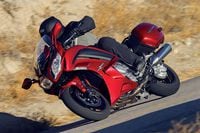
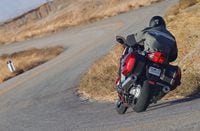



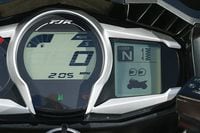



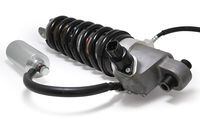
/cloudfront-us-east-1.images.arcpublishing.com/octane/2WF3SCE3NFBQXLDNJM7KMXA45E.jpg)
/cloudfront-us-east-1.images.arcpublishing.com/octane/G4MG6OUCJNBSHIS2MVVOTPX65E.jpg)
/cloudfront-us-east-1.images.arcpublishing.com/octane/IIGGWFOTOJGB7DB6DGBXCCMTDY.jpg)
/cloudfront-us-east-1.images.arcpublishing.com/octane/QSTCM6AVEZA5JJBUXNIQ3DSOF4.jpg)
/cloudfront-us-east-1.images.arcpublishing.com/octane/U4I7G625B5DMLF2DVIJDFZVV6M.jpg)
/cloudfront-us-east-1.images.arcpublishing.com/octane/B6XD6LS6IVCQPIU6HXDJSM3FHY.jpg)
/cloudfront-us-east-1.images.arcpublishing.com/octane/ICL63FEDDRDTTMINYICCEYGMDA.jpg)
/cloudfront-us-east-1.images.arcpublishing.com/octane/FCGZHQXRBZFLBAPC5SDIQLVF4I.jpg)
/cloudfront-us-east-1.images.arcpublishing.com/octane/WNOB6LDOIFFHJKPSVIWDYUGOPM.jpg)

/cloudfront-us-east-1.images.arcpublishing.com/octane/X33NU3E525ECRHXLNUJN2FTRKI.jpg)
/cloudfront-us-east-1.images.arcpublishing.com/octane/6KKT5NNL2JAVBOXMZYS5ZO76YA.jpg)
/cloudfront-us-east-1.images.arcpublishing.com/octane/J5RKG5O455GMPGQRF2OG6LRT7A.jpg)
/cloudfront-us-east-1.images.arcpublishing.com/octane/GX2CIZKQVRH2TATDM26KFG2DAE.jpg)
/cloudfront-us-east-1.images.arcpublishing.com/octane/ZWIDYSAKQZHD5BHREMQILXJCGM.jpg)
/cloudfront-us-east-1.images.arcpublishing.com/octane/CYUHJZCTSJCH3MRAQEIKXK7SCQ.jpg)
/cloudfront-us-east-1.images.arcpublishing.com/octane/LKOFINY56FCXJCANJ5M7ZDQUBY.jpg)
/cloudfront-us-east-1.images.arcpublishing.com/octane/4NBPDACMWJH63JQYJVK3QRBDZI.jpg)
/cloudfront-us-east-1.images.arcpublishing.com/octane/KKHQHRR3FJGX7H2IPU6RALMWG4.jpg)

/cloudfront-us-east-1.images.arcpublishing.com/octane/5IOFS5JAE5FOXMNA23ZRAVVYUU.jpg)
/cloudfront-us-east-1.images.arcpublishing.com/octane/CGXQ3O2VVJF7PGTYR3QICTLDLM.jpg)
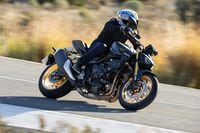
/cloudfront-us-east-1.images.arcpublishing.com/octane/OQVCJOABCFC5NBEF2KIGRCV3XA.jpg)